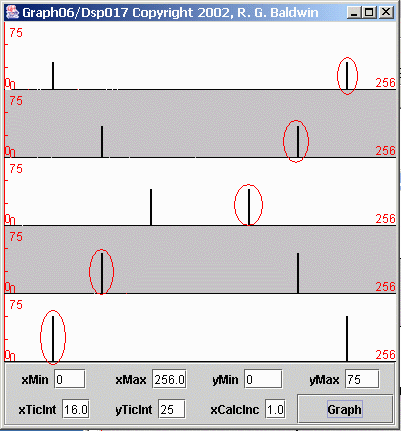| << Chapter < Page | Chapter >> Page > |
In case you are wondering why the peaks in Figure 9 have less structure than the peaks in Figure 7 , this is because the points at which I computed the spectral data in Figure 9 were twice as far apart as the points at which I computed the spectral data in Figure 7 .
(The total frequency range in Figure 9 is twice as wide as in Figure 7 , but I computed the same number of points in both cases.)
Although it's not obvious at this plotting scale, there are zero-valued points between the side lobes on the peaks in Figure 7 .
The points in the spectral display of Figure 9 simply missed the side lobes and hit the zeros between the side lobes. I willhave a lot more to say about this in a future module discussing spectral analysis.
Now let's take another look at the case with the sampling problem. This is the case where the sampling frequency was reduced from four samples per secondto two samples per second but the frequencies of the sinusoids was not changed. This view of the problem is shown in Figure 10 . It will probably be useful for you to compare Figure 10 with Figure 8 .
| Figure 10. Spectral analyses of five sinusoids with sampling problem |
|---|
 |
As with the previous case, each of the plotted spectra in Figure 10 shows the frequency range from zero frequency to the sampling frequency of two samples persecond. The folding frequency of one cycle per second appears in the center of each plot.
The peaks to the left of center in Figure 10 correspond to the peaks in Figure 8 . Because the right edge of Figure 8 is the folding frequency, the peaks to the right of center in Figure 10 don't appear in Figure 8 .
As is always the case, everything to the right of the folding frequency in Figure 10 is a mirror image of everything to the left of the folding frequency.
I have identified the artifacts created by the sampling process with a red oval in Figure 10 .
The problem, as you will recall, is that the frequency of the sinusoids corresponding to the two bottom plots in Figure 10 is above the folding frequency. Thus the peaks to the right of center in the bottom two plots of Figure 10 actually represent the frequencies of the corresponding sinusoids.
Unfortunately, these two peaks appear to the right of the folding frequency, which the area of the spectra that we normally ignore.
Furthermore, these two peaks are reflected through the folded mirror image process into the area to the left of the folding frequency. For these twosinusoids, the peaks to the left of the folding frequency are artifacts, and I have identified them as such with ovals.
I am able to identify these two peaks as artifacts only because I know the true frequency makeup of the raw data. In most real-world situations withunknown data, there would be no way for me to identify these particular peaks to the left of the folding frequency as artifacts.

Notification Switch
Would you like to follow the 'Digital signal processing - dsp' conversation and receive update notifications?